- Home
- Diane Ackerman
The Rarest of the Rare
The Rarest of the Rare Read online
ACCLAIM FOR Diane Ackerman’s
THE RAREST OF THE RARE
“A writer whose back yard … is quite literally the entire planet.… She is dedicated to her subjects in a serious, formal way, even as her inspiration reveals the whimsical, impulsive fascination of scientists.”
—Los Angeles Times Book Review
“Diane Ackerman has spun a treatise that is as accessible as a travel guide, weaving gossamer words that transfix the unwary armchair explorer.… The experience is a sensuous bondage.”
—Baltimore Sun
“Enraptured descriptions of creatures and their habitats conceal meticulous craft … illuminating and impassioned.”
—People
“Smart, compelling, and a pleasure to read.”
—Washington Times
“It is Ackerman’s great gift to make real creatures that are sometimes relegated to mere numbers and abstractions … exhilarating.”
—Miami Herald
“She tackles issues of biodiversity … with intelligence and passion.”
—Seattle Times
“Entertaining, outraged, despairing, passionate, fearful, and hopeful.… Her writing is as original as the animals she encounters.”
—San Francisco Chronicle
BOOKS BY Diane Ackerman
A Slender Thread
The Rarest of the Rare
A Natural History of Love
The Moon by Whale Light
Jaguar of Sweet Laughter: New and Selected Poems
A Natural History of the Senses
Reverse Thunder
On Extended Wings
Lady Faustus
Twilight of the Tenderfoot
Wife of Light
The Planets: A Cosmic Pastoral
FOR CHILDREN
Monk Seal Hideaway
Diane Ackerman’s
THE RAREST OF THE RARE
Poet, essayist, and naturalist, Diane Ackerman was born in Waukegan, Illinois. She received an M.A., M.F.A., and Ph.D. from Cornell University. Her poetry has been published in many leading literary journals and in the books The Planets: A Cosmic Pastoral (1976), Wife of Light (1978), Lady Faustus (1988), and Jaguar of Sweet Laughter: New And Selected Poems (1991).
Her works of nonfiction include A Slender Thread (1996); The Rarest of the Rare (1995); A Natural History of Love (1994); The Moon by Whale Light and Other Adventures Among Bats, Penguins, Crocodilians, and Whales (1991); A Natural History of the Senses (1990); and On Extended Wings (1985), a memoir of flying. Her bestselling A Natural History of the Senses was the basis for a PBS television series, Mystery of the Senses, in which she was featured as host and narrator. Monk Seal Hideaway, her first children’s book, appeared recently, and she is writing other nature books for children.
Ms. Ackerman has received the Academy of American Poets’ Lavan Award, and grants from the National Endowment for the Arts and the Rockefeller Foundation, among other recognitions. Honored as a Literary Lion by the New York Public Library, she has taught at several universities, including Columbia and Cornell. Her essays about nature and human nature have appeared in National Geographic, The New Yorker, The New York Times, Parade, and other journals.
FIRST VINTAGE BOOKS EDITION, JANUARY 1997
Copyright © 1995 by Diane Ackerman
All rights reserved under International and Pan-American Copyright Conventions. Published in the United States by Vintage Books, a division of Random House, Inc., New York, and simultaneously in Canada by Random House of Canada Limited, Toronto. Originally published in hardcover by Random House, Inc., New York, in 1995.
Some of the essays in this work were originally published in other versions in Condé Nast Traveler, Life, National Geographic, The New Yorker, and Parade.
Readers interested in the poems written during some of these trips may wish to turn to Jaguar of Sweet Laughter: New and Selected Poems, where they will find a group of Amazon poems and one set on French Frigate Shoals. They will also find there poems about the Antarctic and other locales mentioned in The Moon by Whale Light.
The Library of Congress has cataloged the Random House edition as follows:
Ackerman, Diane.
The rarest of the rare : vanishing animals, timeless worlds / Diane Ackerman.—1st ed.
p. cm.
eISBN: 978-0-307-76335-8
1. Endangered species. 2. Rare animals.
3. Endangered ecosystems. 4. Monarch butterfly—Migration.
I. Title.
QH75.A32 1995
574.5’29—dc20 95-8499
Random House Web address: http://www.randomhouse.com
v3.1
CONTENTS
Cover
Other Books by This Author
About the Author
Title Page
Copyright
INTRODUCTION
MONK SEALS
IN THE AMAZON, WHERE THE SUN DINES
SHORT-TAILED ALBATROSSES
GOLDEN LION TAMARINS
THE WINTER PALACE OF MONARCHS
INSECT LOVE
INTRODUCTION
On the home planet, in the high latitudes, near the eastern edge of the North American continent, between two glacier-carved mountains, at the foot of a lake where humans balance at speed on knife blades, under gray skies, while ice pellets cover the ground with a thin layer of gooseflesh, in the waking-sleep of December, whose labored breathing is as familiar as a dozing spouse’s, near a county airport, where steel mastodons land calmly but Canada geese circle in honking-mad wedges, among islands of urban forest browsed by white-tailed deer, in a cul-de-sac at the end of a key-shaped lane, behind a modest white house whose windows drink in the sky, one discovers a small part of one’s address: that tilt of planet and mind we call winter.
Despite the cold, my backyard welcomes a riot of species. On two apple trees, mummified fruits hang like rusty bells. Although I cannot hear or smell them, I know that to the deer they are tolling with scent. A Japanese maple outside my study window has lost most of its leaves. The few lifeless, brown, twisted ones that still dangle have so little weight they’re constantly atwitch and ashiver. On the hunched redbud, dry seedpods rattle in the wind like tiny gourds. Cardinals, chickadees, and squirrels use the interlocking branches of the redbud and maple as a highway. Occasionally they slip from an ice-jacketed branch, or tumble when the winds swivel fast. But they’re used to seeing me behind the windowpanes, at a safe distance. I judge the direction and force of the wind from watching them. For warmth, they stand facing the wind, so it blows in the same direction their feathers or fur grows. Today the cardinals are puffed up like wads of cotton candy, and they’re all pointing east.
Although I rarely spot field mice and shrews in the flesh, I often see them tunneling beneath the snow. Sometimes a rabbit or a groundhog strays from its nest. The five raccoons, balled up in the trunk of a half-dead maple tree on the north side of the house, wore a path across my lawn all summer, tumbled the garbage cans, and skittered across the roof. I know just where their den is—a hundred feet up in a gouged-out bolus of wood—because one pantingly hot summer day they crept slowly out of their nest and draped themselves on the branches to cool off. I’m not sure where the garter snakes have gone for the winter. Some years, at springtime, I find them waking indoors, so I suspect they’ve found a toasty bolt-hole in the walls or near the furnace. Three brown bats are hibernating under a house eave. Crows as big as eggplants weigh down the trees. Other birds visit the feeders, leaving footprint hieroglyphics in the snow. I miss the frogs and insects and spiders and butterflies that combine in warm weather to make a tapestry of fidget and color that stretches from belowground to the sky. I miss the flowers, whose buoyant
colors and smells drench one’s senses. But even in winter, many life-forms homestead this small piece of world.
From a bookcase by my desk, I pull out a copy of one of my favorite books, The Home Planet, a dazzling collection of photographs of Earth taken from space, and open it to a particularly beautiful shot of the Indian Ocean with a feathery smear of clouds above it: Earth at its most marblelike and blue. The oceans that gave birth to us support vast herds of living things—not least the phytoplankton, right at the bottom of the food chain, on which much of life on Earth depends. How can we allow something as large as an ocean to die? And yet, the Great Lakes are nearly dead. The Mediterranean is in its death throes. Some whales contain such high levels of poison from all the pollutants dumped into the ocean that even though they’re living animals, they would qualify technically as toxic waste.
Leafing idly through The Home Planet, I stop at a picture of Earth floating against the black velvet of space. Africa and Europe are visible under swirling white clouds, but the predominant color is blue. This was the one picture from the Apollo missions that told the whole story—how small the planet is in the vast sprawl of space, how fragile its environments are. Seen from space, Earth has no national borders, no military zones, no visible fences. Quite the opposite. You can see how storm systems swirling above a continent may well affect the grain yield half a world away. The entire atmosphere of the planet—all the air we breathe, all the sky we fly through, even the ozone layer—is visible as the thinnest rind. The picture eloquently reminds one that Earth is a single organism. For me, the book contains visual mnemonics of how I feel about nature. At some point, one asks, “Toward what end is my life lived?” A great freedom comes from being able to answer that question. A sleeper can be decoyed out of bed by the sheer beauty of dawn on the open seas. Part of my job, as I see it, is to allow that to happen. Sleepers like me need at some point to rise and take their turn on morning watch, for the sake of the planet, but also for their own sake, for the enrichment of their lives. From the deserts of Namibia to the razor-backed Himalayas, there are wonderful creatures that have roamed Earth much longer than we, creatures that not only are worthy of our respect but could teach us about ourselves.
Some of those wilds I know personally, at the level of sand, orchid, wingless fly, human being. So each photograph is an album, a palimpsest, a pageant. There is Torishima, the little island south of Tokyo, which is the final stronghold of short-tailed albatrosses. There is French Frigate Shoals, the last refuge of the Hawaiian monk seal. There is Antarctica, home to vast herds of animals. While I look at a photograph of the Hawaiian Islands—puddles of ink on a bright copper sea—I remember the sound and rumble of humpback-whale song cresting over me as I swam. Humpback whales have had a civilization without cities, a kind of roaming culture, for many ages. They live in the ocean as in a wide blue cave. They pass on an oral tradition, teach one another their songs, abandon old versions, use rhyme. Our recordings of them go back only to 1951, but after more than forty years, the whales haven’t returned to their original songs of the fifties. Just imagine the arias, ballads, and cantatas of ancient days that have filled the oceans with song, then died out, never to be heard again. Today we can visit the campfires of a few remaining tribes of Stone Age people and hear the stories they tell, stories marvelous, imaginative, and rich with wonder. But we will never know all the lost stories of the cave people. The same may be true of humpback whales. As I page through the book, I feast on habitats far-flung and dizzying. Life haunts every one of them, no matter how distant, dry, hot, salty, or sunless. The photograph of Africa reminds me of the giant animals caged forever in the past. The large animals we associate with Africa—elephants, giraffes, hippos, ostriches, and others—are dwindling remnants of the massive creatures that once flourished. Indricotherium, a relative of the hippo, measured about twenty feet at the shoulder and browsed on the tops of trees. A person standing beside it would barely reach its knee. There were mammoths bulkier than elephants, beavers the size of bears, jumbo elk with huge trellises for antlers, towering horses, bison as broad as a car. And, of course, there were Neanderthals, big, burly hominids, related to us. Were they a slightly different species, a competitor we killed off? Neanderthals survived in Europe, practicing burial rites and other religious rituals, for about seventy thousand years. Then Homo sapiens appeared, with their cave paintings and quick minds, and before long all the Neanderthals disappeared. When I look at the photographs of Borneo, Brazil, and New Guinea, I remember how the dynamic well of the rain forests has generated new life-forms. Our genetic safety net is woven from their biodiversity.
I set the book down on the table beside me in a puddle of sunlight. At one time or another, life has auditioned all over the earth. About forty million different species share our planet right now, and that seems like a cornucopia, but ten times that many have lived here in the past. Some scientists put the estimate close to fifty billion species. Because the human life span is short, record keeping recent, and our collective memory so poor, some assume that rhinos and elephants are forever, that we are forever. Evolution, that slow and steady plodder, will protect us through sheer sloth, won’t it? Reassured by the logic of “If it ain’t broke, don’t fix it,” we feel secure about the gradualness of time. Anyway, according to myth and religion, we are evolution’s goal. But 99 percent of all species on the planet have gone extinct, including some of our close relatives. Just because we have evolved minds that crave order doesn’t mean that nature is orderly. Evolution is a sleeping watchdog. It is possible for us to disturb it, or it may wake on its own. Either way, expect commotion.
The word extinct comes from the Latin stinguere (to quench), which is the verb of choice for killing a flame. Because we live on a planet hospitable to fires, which consume but also heat, we are obsessed with the notion of fires within our own bodies. This is not just a metaphor that came in with the Industrial Age’s dynamos and furnaces; the ancients also wrote of fire in the flesh. When we say something is extinct, we mean literally that the flame in each and every cell has been doused. Yet we use extinct not as a verb but as an adjective attached to the verbs become and go. Even in our use of the word, we are confused about whether extinction happens to a species or is caused by that species. Subconsciously, we think of it as a supreme failure. We do not realize that extinction is normal. There have been huge die-offs in the past, when many species disappeared, discarded by evolution in a doodling with life-forms that may seem heartless, mindless, merciless, but is also unmalicious, intentionless, random. The high extinction rate at the moment is unique within our span of recorded time, so it surprises us; but mass extinctions are not extraordinary. What should unnerve us is that, in the past, large waves of extinction have always wiped out the culprits: when organisms were too abundant, dominating the earth and ruining the environment, they went extinct, with countless other animals. Then a new form of ooze or mouse started evolution all over again. So it’s not that large numbers of animals haven’t gone extinct before, or that nature cannot take care of itself. It’s that when nature does, things start off from scratch in a new line of evolution, and that line may not include beings like us. Humans could be among the fossils other life-forms speculate about one day (if they speculate), puzzling over our tragedy as we puzzle over the dinosaurs’. The systems that now exist on earth have taken hundreds of millions of years to develop, but they could collapse around our ears, collapse rapidly and take us with them. That doesn’t mean that all life on earth would vanish, but that it might be radically different. There have been times when anaerobic creatures ruled and times when aerobic ones thrived. Five deer leaped into my yard this morning, to eat fallen apples beneath the two trees by my study. With coats thick and dark, they looked like burros. There was a time when dinosaurs grazed in this same region, and I lament their passing. But if dinosaurs still ruled the planet, we would not be here. It was their extinction that made room for the small, timid, nocturnal mammals that led to us.
Even to the most pious disciples of the planet, there are many forms of the sacred, many rituals of devotion. Some people see nature as too holy to touch; they believe it should be allowed to run free and fend for itself, finding its own equilibrium, obliterating species willy-nilly. This fatalistic view sees us simply as one facet of nature among many other equally extraordinary facets; it may include a notion of God as an absentee landlord. Some people object to the way we “play God,” choosing to save some animals and pull the plug on others. For example, should so much environmental money have been spent on the condor, whose role as a scavenger has been eroded by civilization? Some believe that all life is sacred and therefore all species must be preserved. Others argue that what is sacred is the mechanism of nature, and that one of nature’s ways is to abort species that aren’t adapting well, and to burn down forests as a means of refertilizing the soil. That makes more resources and space for other species. I happen to find koalas and pandas wonderful creatures, and for selfish reasons I would hate to see them vanish. But they rely on such precarious niches that their survival is doubtful. The koala eats only eucalyptus; a eucalyptus blight would be its doom. If we are driving species to extinction, we should stop. But if we’re not at fault, should we interfere? For that matter, who owns an endangered species? What makes this issue more complicated is that it’s no use protecting an animal by itself; you have to protect its entire habitat. When people contribute to the Save the Panda campaign of the World Wildlife Fund, the money actually goes to protect the habitat of the pandas, not just the animal.
If extinction is normal, then those who champion a laissez-faire relationship with nature have nothing to fret about. We’ll lose some species, gain others. But people who cherish life on earth as it is now should be worried. The vanishing of so many other animals may indicate that we’re not far from the brink ourselves. If we’d like our species to hang around for a while, we must be vigilant about what we’re doing to other species, because evolution is a set of handshakes, not a list of winners. As Gregory Bateson points out in Sacred Unity: Further Steps to an Ecology of Mind: “The horse isn’t the thing that evolved. What evolved actually was a relationship between horse and grass.… Thus the unit of what’s called evolution out there is really not this species or that species. It’s an entire interlocking business of species.”

 A Natural History of Love
A Natural History of Love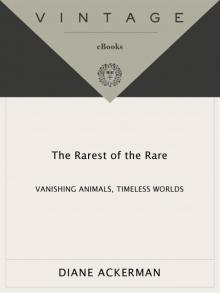 The Rarest of the Rare: Vanishing Animals, Timeless Worlds
The Rarest of the Rare: Vanishing Animals, Timeless Worlds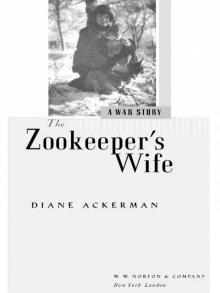 The Zookeeper's Wife: A War Story
The Zookeeper's Wife: A War Story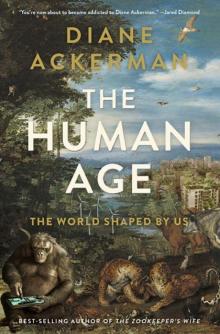 The Human Age: The World Shaped by Us
The Human Age: The World Shaped by Us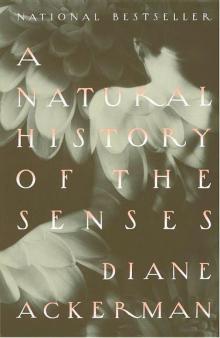 A Natural History of the Senses
A Natural History of the Senses One Hundred Names for Love: A Memoir
One Hundred Names for Love: A Memoir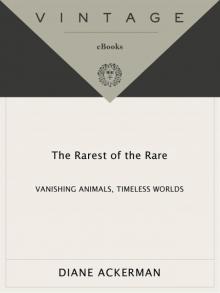 The Rarest of the Rare
The Rarest of the Rare